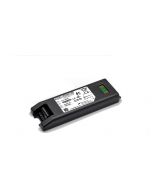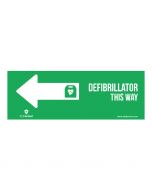Physio Control LIFEPAK CR2 Fully Automatic Defibrillator with WIFI
In stock
The LIFEPAK CR2 Wi-Fi Enabled Fully Automatic defibrillator revolutionises the technology AEDs use to treat patients in the crucial moments of a cardiac arrest.
Key Defibrillator Features
- Paediatric Switch
- Always connected via LIFELINKcentral program manager
- ClearVoice Technology adapts the volume of the voice prompts in order to be clear and heard in any environment
- Readiness status flashes every 6 seconds, indicating the device is ready for use
- Location readily available
- Fastest time to start CPR
- Bilingual feature
- IP55 Rating
With an impressive rating of IP55, it boasts impressive protection against dust and water, making it a highly efficient defibrillator that is ideal for all weather conditions and working environments.
What's Included?
- 1x LIFEPAK CR2 with WIFI
- 1x Physio Control CR2 Electrode Kit- up to 4 year shelf-life
- 1x Physio Control Lifepak CR2 Battery - up to 4 year shelf-life
- 1x CR2 Carry Case
- 1x Safe Life Rescue Kit
- 8 Year Manufacturing Warranty - or benefit from our 10 year warranty by registering here
Additional products available for this unit
Read More here: Forward Hearts Program
More information
For more information, you can contact the friendly defibshop team on 0161 776 7422.
| Connectivity | WIFI |
|---|---|
| MDR Approved | In Progress |
| FDA Approved | Yes |
| Warranty | 8 Year Manufacturer's Warranty |
| IP Rating | 55: the AED is protected against limited dust ingress and low pressure water jets from any direction |
| Defib Brand | Physio Control |
| Semi/Fully Automatic | Fully Automatic |
| Battery Life | Up to 4 years |
| On Screen ECG | No |
| Energy Delivery | Escalating |
| Manual Override | No |
| Memory | 60 mins |
| Pad Life | Up to 4 years |
| Dimensions | H: 9.7cm x W: 22.6cm x D: 27.4cm |
| Product Weight | 2.0kg |
| Dangerous Goods | Yes |
| Icon | Label | Description | Type | Size | Download |
|---|---|---|---|---|---|

|
Physio Control LIFEPAK CR2 Operating Instructions | Defibrillator operators guide | 6.6 MB | Download |
The first of its kind, the LIFEPAK CR2 Wi-Fi Enabled Fully Automatic defibrillator revolutionises the technology AEDs use to treat patients in the crucial moments of a cardiac arrest.
More Information
For further information about this product, get in touch with a member of our team on 0161 776 7422.
What is a fully-automatic defibrillator?
A fully automated defibrillator requires little user interaction to deliver an electric shock to someone in Sudden Cardiac Arrest. After turning the unit on, the responder should pull the red handle to reveal the electrode pads and place them on the casualty's chest. The unit then assesses the heartbeat and delivers a shock, if required, with a 3,2,1 countdown. CPR can then be commenced when prompted.
What is ClearVoice Technology?
ClearVoice technology adapts the volume of the voice prompts depending on the environment. Specifically designed for portable medical devices, the adaptive volume aids responders in delivering potentially life-saving treatment regardless of their surroundings. Sudden Cardiac Arrest can occur at any time, and having a defibrillator with ClearVoice technology will remove noise interference during use
ClearVoice technology reduces distortions and improves speech intelligibility, so the user can confidently hear the prompts even when the environment is hectic and noisy.
What battery is required for the Lifepak CR2 Fully-Automatic Defibrillator?
The battery required for the Lifepak CR2 Fully-Automatic Defibrillator is lithium manganese dioxide, weighing only 0.3 kg. When stored correctly, the battery has a standby life of four years when unused. The battery is durable but should be stored at specific temperatures to maintain it correctly. When storing the unit long-term, its temperature should be between 0 and 25 degrees. The humidity levels should be kept between 5 and 95% at all times.
How often can you shock someone with the Lifepak CR2 Fully-Automatic Defibrillator?
As the Lifepak CR2 Fully-Automatic Defibrillator is fully-automatic, the user is not required to administer any electric shocks to the casualty. The device will analyse the person's heart rhythm and then deliver shocks if required, accordingly. From there, the defibrillator will guide the responder through delivering CPR.






